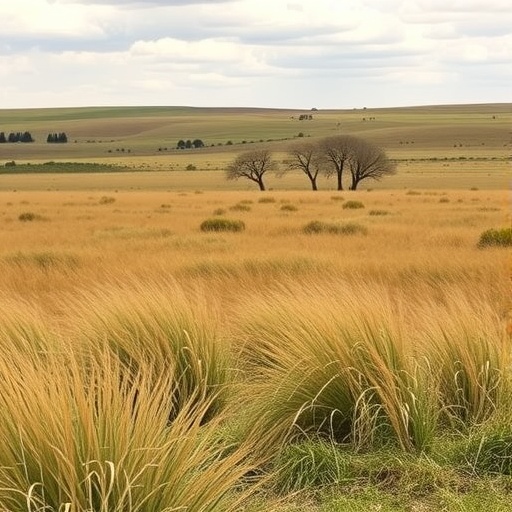Increasing Nitrogen and Rainfall May Dramatically Boost Greenhouse Gas – Bioengineer.org

Report on Soil Denitrification in Steppe Ecosystems and Implications for Sustainable Development Goals
1.0 Introduction: Climate Action and Terrestrial Ecosystems
A recent study on Eurasian steppe ecosystems provides critical insights into greenhouse gas dynamics, directly informing progress toward the United Nations Sustainable Development Goals (SDGs), particularly SDG 13 (Climate Action) and SDG 15 (Life on Land). The research investigates the increasing threat of nitrous oxide (N₂O) emissions from grasslands, a potent greenhouse gas with a warming potential nearly 300 times that of carbon dioxide. Understanding these emissions is fundamental to developing effective climate mitigation strategies and ensuring the sustainable management of terrestrial ecosystems.
2.0 Research Scope and Methodology
The investigation, led by the Chinese Academy of Sciences, focused on the soil denitrification process across three major plateau regions. The methodology involved a comprehensive analysis to understand the environmental drivers of N₂O emissions.
- Geographic Focus: The Loess Plateau, Inner Mongolian Plateau, and Xizang Plateau.
- Data Collection: 150 soil samples were collected from 30 undisturbed grassland sites across diverse environmental gradients.
- Analysis: Controlled laboratory incubations were conducted to measure the potential release of N₂O and nitrogen gas (N₂) under standardized conditions, including simulated nitrogen enrichment.
3.0 Key Findings and Relevance to Sustainable Development Goals
3.1 Nitrogen Inputs and Climate Action (SDG 13)
The study reveals a direct and significant link between anthropogenic nitrogen inputs and increased greenhouse gas emissions, posing a challenge to climate action targets.
- Increased N₂O Emissions: Nitrogen enrichment was found to increase N₂O emissions by an average of 65% across the studied soils. This highlights the urgent need to manage nitrogen pollution from sources such as agriculture to meet the goals of SDG 13.
- Emission Hotspots: Soils from the Inner Mongolian and Xizang Plateaus were identified as potential hotspots, producing approximately double the N₂O compared to the Loess Plateau. This spatial variability underscores the necessity for targeted, region-specific climate mitigation policies.
3.2 Ecosystem Health and Life on Land (SDG 15)
The research underscores the vulnerability of grassland ecosystems to environmental change, emphasizing the importance of sustainable land management practices to protect biodiversity and ecosystem services as outlined in SDG 15.
- Primary Driver of Denitrification: At a broad scale, total soil nitrogen was the predominant factor controlling denitrification. This links soil health directly to its role in the global climate system.
- Complex Interactions: At a local scale, the interplay between total soil carbon, mean annual precipitation, and total nitrogen dictates N₂O emissions. This complexity demonstrates that protecting life on land requires an integrated approach that considers soil health, water cycles, and nutrient management.
- Role of Soil Health: Soils with higher organic carbon and moderate acidity demonstrated more efficient conversion of N₂O to harmless N₂ gas. This finding suggests that management practices promoting soil organic carbon sequestration can serve as a dual strategy for achieving both SDG 13 and SDG 15.
3.3 Implications for Sustainable Food Systems (SDG 2) and Water Quality (SDG 6)
While not the primary focus, the study’s findings on nitrogen cycling have clear implications for other SDGs. The link between nitrogen inputs (often from agricultural fertilizers) and N₂O emissions highlights the need for sustainable agricultural practices that support SDG 2 (Zero Hunger) without compromising climate and environmental goals. Managing nitrogen runoff is also critical for protecting water resources, a key target of SDG 6 (Clean Water and Sanitation).
4.0 Recommendations for Policy and Future Action
4.1 Enhancing Climate Models and Policy
The detailed spatial and mechanistic data from this study should be integrated into global climate models to improve the accuracy of greenhouse gas inventories. This will enable more effective, evidence-based policymaking for climate action.
- Develop nuanced, region-specific emission reduction strategies that account for the unique soil and climatic conditions of different grassland ecosystems.
- Incorporate soil health metrics, such as organic carbon content, into land management policies as a tool for mitigating greenhouse gas emissions.
4.2 Fostering Partnerships for the Goals (SDG 17)
The success of this research, supported by multiple national foundations, exemplifies the value of SDG 17 (Partnerships for the Goals). Continued investment in interdisciplinary scientific collaboration is essential for addressing complex environmental challenges.
- Promote long-term monitoring programs for sensitive ecosystems to track changes in soil-atmosphere interactions under evolving climate scenarios.
- Integrate microbial functional traits into ecosystem models to better predict the response of terrestrial ecosystems to anthropogenic pressures.
5.0 Conclusion
This research provides a critical foundation for understanding the role of grassland soils in the global climate system. By elucidating the drivers of nitrous oxide emissions, the study reinforces the interconnectedness of the Sustainable Development Goals. Achieving climate stability (SDG 13) is intrinsically linked to the sustainable management of terrestrial ecosystems (SDG 15) and requires transformative changes in sectors such as agriculture (SDG 2). The findings call for integrated policy and management practices that safeguard soil health to ensure the long-term ecological integrity and climate-regulating function of the world’s vital grassland landscapes.
Analysis of Sustainable Development Goals in the Article
1. Which SDGs are addressed or connected to the issues highlighted in the article?
-
SDG 13: Climate Action
- The article’s central theme is the emission of nitrous oxide (N₂O), a potent greenhouse gas with a “global warming potential nearly 300 times that of carbon dioxide,” from grassland ecosystems. It directly addresses the drivers of these emissions and their implications for “global climate feedbacks” and the need for “climate change mitigation.”
-
SDG 15: Life on Land
- The research focuses on terrestrial ecosystems, specifically the “world’s largest grassland regions” and “vast steppe ecosystems.” It examines soil health, microbial processes, and the impact of nitrogen pollution on these ecosystems. The article calls for “informed management practices aimed at reducing greenhouse gas outputs while maintaining the ecological integrity of these vital landscapes,” which aligns with the goal of protecting and sustainably managing life on land.
-
SDG 9: Industry, Innovation, and Infrastructure
- The article describes a “groundbreaking study” that represents a “significant advancement in our understanding of soil denitrification processes.” It highlights the importance of scientific research and innovation, supported by national funding bodies like the “Natural Science Foundation of Hebei Province,” to address complex environmental challenges. This aligns with the goal of enhancing scientific research and technological capabilities.
-
SDG 17: Partnerships for the Goals
- The study is presented as a result of “collaborative efforts between soil scientists, ecologists, and biogeochemists.” This interdisciplinary approach, combined with support from various foundations, exemplifies the partnerships needed to “unravel complex environmental challenges” and bridge the gap “between fundamental research and applied environmental stewardship.”
2. What specific targets under those SDGs can be identified based on the article’s content?
-
Under SDG 13 (Climate Action):
- Target 13.2: Integrate climate change measures into national policies, strategies and planning. The article directly supports this by providing a “critical foundation for improving predictive greenhouse gas models” which can inform “policy and land management strategies” and “emission reduction strategies.”
- Target 13.3: Improve education, awareness-raising and human and institutional capacity on climate change mitigation. The research itself contributes to this target by filling a “critical knowledge gap” and advancing “scientific understanding” of greenhouse gas emissions, which is essential for building capacity to address climate change.
-
Under SDG 15 (Life on Land):
- Target 15.1: Ensure the conservation, restoration and sustainable use of terrestrial and inland freshwater ecosystems. The study’s ultimate goal is to pave the way for “informed management practices” that protect the “ecological integrity of these vital landscapes” (grasslands), which is central to their sustainable use and conservation.
- Target 15.3: Combat desertification, restore degraded land and soil… and strive to achieve a land degradation-neutral world. The article emphasizes that “maintaining soil health may be integral to controlling greenhouse gas fluxes.” It investigates the impact of anthropogenic nitrogen inputs, a form of land degradation, and provides insights into how soil properties like organic carbon can mitigate harmful emissions, contributing to the goal of restoring degraded soil.
-
Under SDG 9 (Industry, Innovation, and Infrastructure):
- Target 9.5: Enhance scientific research, upgrade the technological capabilities… encouraging innovation. The article is a direct example of this target in action. It describes a “pioneering study” using “methodological rigor” that was supported by foundations “dedicated to enhancing environmental science and technology within China.”
-
Under SDG 17 (Partnerships for the Goals):
- Target 17.16: Enhance the global partnership for sustainable development, complemented by multi-stakeholder partnerships that mobilize and share knowledge. The article highlights the “collaborative efforts between soil scientists, ecologists, and biogeochemists,” showcasing a multi-stakeholder partnership that shares knowledge to advance global climate science.
3. Are there any indicators mentioned or implied in the article that can be used to measure progress towards the identified targets?
-
Nitrous Oxide (N₂O) Emissions:
- The most direct indicator is the measurement of greenhouse gas emissions. The study directly measured the “potential of these soils to release both nitrous oxide and nitrogen gas” and found that nitrogen addition led to a “65 percent increase in N₂O release.” This is a key metric for tracking progress on climate mitigation (SDG 13).
-
Soil Nitrogen and Carbon Content:
- The article identifies “total soil nitrogen” as the “predominant driver modulating denitrification activity” and notes that “soil carbon content” impacts the efficiency of the process. These soil properties are measurable indicators of ecosystem health and its potential to emit or mitigate greenhouse gases, relevant to SDG 15.
-
Anthropogenic Nitrogen Inputs:
- The study simulates the effect of “anthropogenic nitrogen inputs” and “increasing nitrogen deposition.” Monitoring the rate of nitrogen deposition in these ecosystems would serve as an indicator of environmental pressure that drives N₂O emissions, linking to both SDG 13 and SDG 15.
-
Investment in Environmental Research:
- The article explicitly mentions that the research was “generously supported by the Natural Science Foundation of Hebei Province, the China Postdoctoral Science Foundation, and other programs.” The level of funding and number of scientific publications on this topic can serve as an indicator for progress on enhancing scientific research (Target 9.5).
4. Table of SDGs, Targets, and Indicators
| SDGs | Targets | Indicators |
|---|---|---|
| SDG 13: Climate Action | 13.2: Integrate climate change measures into national policies, strategies and planning. | Amount of nitrous oxide (N₂O) emissions from grassland soils. |
| SDG 15: Life on Land | 15.3: Combat desertification, restore degraded land and soil… and strive to achieve a land degradation-neutral world. | Total soil nitrogen and total soil carbon content as measures of soil health and emission potential. |
| SDG 9: Industry, Innovation, and Infrastructure | 9.5: Enhance scientific research, upgrade the technological capabilities… encouraging innovation. | Funding and support for environmental science and technology research (e.g., from Natural Science Foundations). |
| SDG 17: Partnerships for the Goals | 17.16: Enhance the global partnership for sustainable development… that mobilize and share knowledge. | Number of interdisciplinary collaborative research projects between different scientific fields (e.g., soil science, ecology, biogeochemistry). |
Source: bioengineer.org
What is Your Reaction?
 Like
0
Like
0
 Dislike
0
Dislike
0
 Love
0
Love
0
 Funny
0
Funny
0
 Angry
0
Angry
0
 Sad
0
Sad
0
 Wow
0
Wow
0
















































/environment-climate-change-and-health-(ech)/water-sanitation-hygiene-and-health-(wsh)/landfill-tuvalu-36092.tmb-1200v.jpg?sfvrsn=5c21fe40_1#)

.jpg.webp?itok=0ZsAnae9#)


























